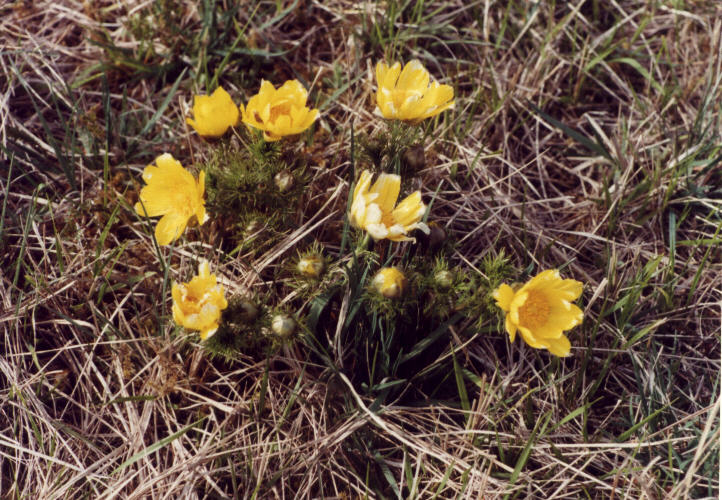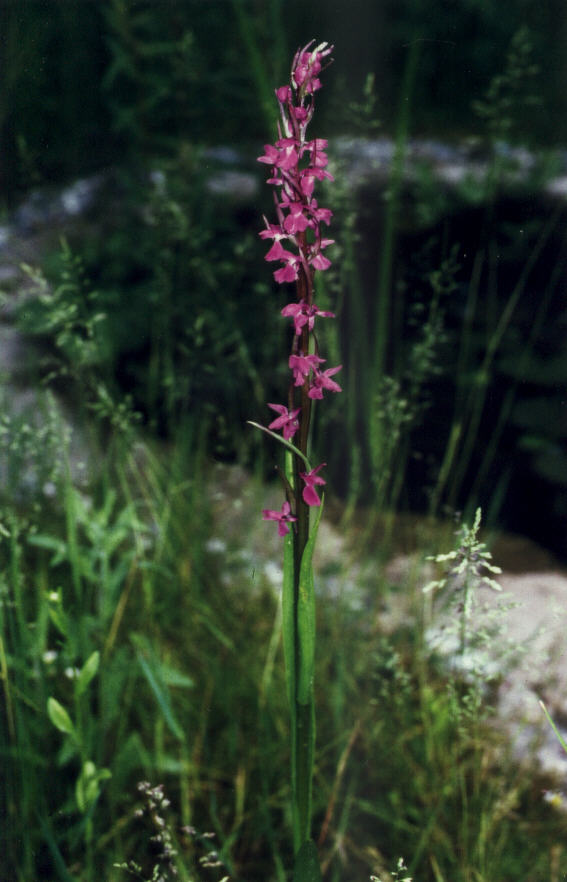
|
"Do you know how many echo parakeets there are in the wild?" exclaimed Richard. "Fifteen! That's rare. Hundreds is common."
Douglas Adams, "Last chance to see..."
|
In this gallery I would like to present a few plants which are very endangered or extinct in my region in southwest Germany. Attempts to reintroduce them in places where they have grown in the wild usually bring punishment instead of encouragement by the official nature protection. The plants which have been marked with an asterisk* have been photographed by me in the garden, I have removed the mother plants in the meantime after I have discovered how unwanted all work in this direction is. A quote from the book "Orchids in the garden" by Kohls and Kaehler: "The demonstrative transplanting of some orchids to save them from the bulldozer gave a couraged nature protecting woman a monetary fine." I think the majority of the officials which work in nature protection nowadays are arrogant, corrupt and ignorant idiots which work only after the minimum principle, enjoy playing the great inquisitors and show real interest only in their biotope mapping, everything else means crap for them! The few sympathetic and competent exceptions are already entangled too deep in the hierarchy of force to be able to do much; it's time for a reformation of the nature protection. I would be happy about all fellows who help me to fight politically and legally against the perverted things in nature protection.

Orchis palustris*
(See map)
This extremely rare Orchis species has become practically extinct in southwest Germany. A well-known biotope in a clay pit has been explored by me and may be extinguished. Orchis palustris needs wet lime meadows which fall dry in the summer. Since these biotopes are extremely isolated, active transplation combined with biotope construction measures may be sensible here.
Adonis vernalis
(See map)
This plant of the steppes can still be found in large numbers in some regions like Bavaria. In southwest Germany many biotopes have been destroyed by agriculture and vineyards. Near Gruenstadt/SW-Germany some plants have been released illegally, according to the current legal situation these plants would have to be removed and the responsible persons would have to be prosecuted immediately.
Pulsatilla vernalis*
(See map)
While the violet Pulsatilla vulgaris has recovered very well in my region and can be bought from gardeners, too, this beautiful flower is strictly avoiding lime and can be found mainly in upper mountain regions. It is known as difficult in culture, in a lime free sand bed I have managed to grow it from seeds, however. Occurences in southwest Germany are considered extinguished.
Frittilaria meleagris*
(See map)
This interesting flower of the wet meadows is very endangered in SW Germany and has become extinct in many regions. The only biotope which I know near Wachenheim has become extinguished.
Dactylorhiza sambucina
(See map)
This very rare orchid grows in my region exactly in one spot with ryolite soil, unfortunately only in the yellow version. It's known as notoriously difficult in culture and requires extensive biotope preparations. But it already has been successfully used to cross-breed garden forms.
Gladiolus palustris*
(See map)
Another candidate for the category almost extinct plants in southwest Germany. This tiny plant, compared with the Gladiolus species of the frontyards, can be cultivated rather easily in a moist meadow near the edge of a pond.
Orobanche hederae*
(See map)
This is an example that even parasitic plants can be cultivated with patience and a little luck. This species grew on ivy in my garden two years after sowing the seeds. It seems to occur only on one place in the wild in my region.
Cypripedium calceolus
It may be controversial to decide if the so-called queen of the european orchids is really more beautiful than the slender beauty of the Lax-flowered Marsh Orchid or the Martagon Lily. But it is fact that this orchid has been extinguished in many places and the nature protection elite keeps the few remaining places as a secret and defends them with a determination which exceeds even the other orchids. I have never seen a Cypripedium calceolus in the wild, the depicted colony grows for many years in the backyard of a professional gardener. The reintroduction of these plants in places where they have formerly grown and been extinguished by human actions is considered as "floral falsification". Thank you very much for the official nature protection!
Nigritella nigra
(See map)
An even more extreme example for the effectiveness of the official nature protection. This dried plant is all that remains of an isolated population in the upper hills of southwest Germany. Since Nigritella is an alpine plant which usually grows between 1000 and 2000 meters above the sea level, this remote population was unique and precious. It was so precious for the local farmers that this place is now transformed in a fenced-in place for big cattle. It is so precious for the nature protection elite that there will never be a replacement biotope with new plants because the closest plants grow in the Alps, several hundred kilometers away. But the autochtone plants are -dead-.
Back to the nature protection title page